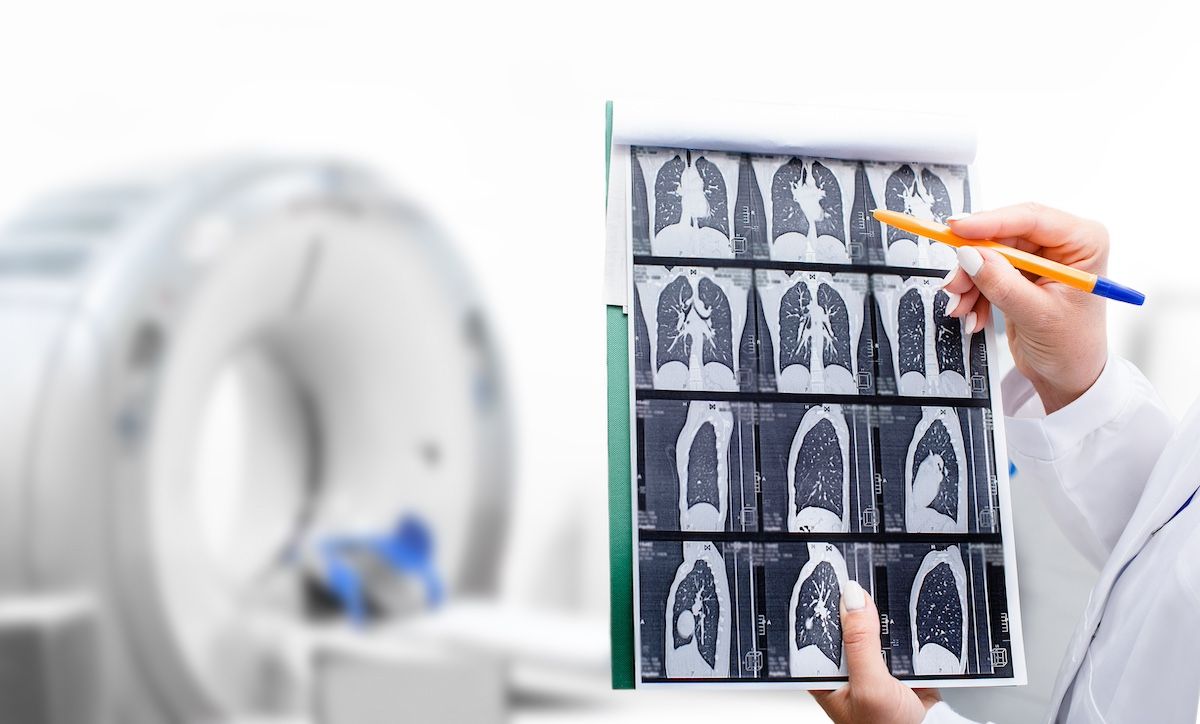- Center on Health Equity and Access
- Clinical
- Health Care Cost
- Health Care Delivery
- Insurance
- Policy
- Technology
- Value-Based Care
Alectinib Significantly Improves Disease-Free Survival in ALK-Positive NSCLC
Seeking more data on adjuvant alectinib in patients who have resectable ALK-positive non–small cell lung cancer (NSCLC), investigators compared outcomes vs chemotherapy.
At 2 years in the ALINA trial, patients on alectinib had a 76$ reduced risk of death or disease recurrence | Image Credit: PeakStock - stock.adobe.com

Disease-free survival (DFS) among patients living with resectable ALK-positive non–small cell lung cancer (NSCLC) showed significant improvement following adjuvant treatment with the kinase inhibitor, alectinib, compared with platinum-based chemotherapy, according to a new primary data analysis published in The New England Journal of Medicine.
ALK-positive disease accounts for 4% to 5% of all NSCLC cases. Patients with this cancer subtype also tend to be younger, nonsmokers, and diagnosed at a more advanced stage compared with individuals who receive a diagnosis of ALK-negative NSCLC.
In the global phase 3 open-label ALINA trial (NCT03456076), between 4 and 12 weeks after surgical rection for their cancer (lobectomy, sleeve lobectomy, bilobectomy, or pneumonectomy, patients were randomized 1:1 to treatment with either 600-mg twice-daily oral alectinib (n = 130) or intravenous chemotherapy (n = 127) for four 21-day cycles, which is the current standard of care for ALK-positive NSCLC. All patients included had completely resected ALK-positive NSCLC stage 1B, II, or IIIA. DFS, the primary end point, was investigated hierarchically in patients with stage II or IIIA disease and an intention-to-treat (ITT) cohort. Secondary end points were central nervous system (CNS) DFS, overall survival, and safety.
“Although the treatment landscape for early-stage NSCLC is rapidly evolving with the approval of cancer immunotherapy and targeted therapy regimens,” the authors wrote, “adjuvant targeted therapy in patients with resectable NSCLC harboring a rearrangement in the ALK gene (ALK-positive NSCLC) warrants evaluation.”
For patients with stage II or IIIA disease—116 patients receiving alectinib and 115 receiving chemotherapy—there was a 76% reduction in risk of disease recurrence or death with alectinib vs chemotherapy (HR, 0.24; 95% CI, 0.13-0.45; P < .001), in that 93.8% of patients who received treatment with alectinib had DFS at 2 years compared with 63.0% treated with chemotherapy; at 3 years, the numbers were 88.3% and 53.3%, respectively. A similar trend was seen for the ITT population: 93.6% vs 63.7%, for another 76% reduced risk (HR, 0.24; 95% CI, 0.13-0.43; P < .001) at 2 years, and 3 years, 88.7% and 54.0%, respectively.
In addition for the ITT cohort, there was a clinically meaningful benefit for CNS DFS, at a 78% reduction in risk of disease recurrence or death with alectinib vs chemotherapy (HR, 0.22; 95% CI, 0.08-0.58).
Alectinib was administered for 2 years or the first of disease recurrence, unacceptable toxicity, or consent withdrawal. Chemotherapy could be cisplatin 75 mg/m2 and vinorelbine 25 mg/m2 on days 1 and 8, gemcitabine 1250 mg/m2 on days 1 and 8, or pemetrexed 500 mg/m2 on day 1. Carboplatin at an area under the curve of 5 or 6 mg/mL/min could be substituted for cisplatin if patients could not tolerate the latter.
Female patients comprised more of the alectinib cohort vs the chemotherapy cohort (57.7% vs 46.5%), as well as those without a smoking history (64.6% vs 55.1%). No patients overall received radiotherapy.
Median follow-up for the ALINA trial was 27.8 months overall, and slightly longer in the chemotherapy vs the alectinib group: 28.4 vs 27.8 months. By data cutoff, 3 times more patients with stage II or IIIA disease in the chemotherapy group had died or experienced disease recurrent vs the alectinib group: 45 vs 14. In the ITT analysis, these patient totals were 50 and 15, respectively. The most common site of disease recurrence was the brain.
In the safety analysis of 248 patients, median duration of alectinib treatment was 23.9 months, and chemotherapy, 2.1 months. Most patients in each group reported at least 1 adverse event (AE); no fatal AEs were reported. The most common AEs were increased creatine kinase, constipation, nausea, and decreased appetite.
The investigators highlighted that alectinib’s DFS benefit was consistent, even when evaluating outcomes by disease stage, race, sex, and smoking status, and that the few cases of brain metastases they saw—3.1% of the alectinib group and 11.0% of the chemotherapy group—indicate alectinib’s potential to prevent or delay CNS recurrence.
They concluded by emphasizing the importance of biomarker testing for ALK alteration in all stages of NSCLC.
“Currently, biomarker testing for ALK alterations in resectable NSCLC is mainly performed to exclude patients from receiving immunotherapy,” they wrote, “but routine ALK testing should also support identification of patients who are likely to benefit from adjuvant alectinib.”
Reference
Wu YL, Dziadziuszko R, Ahn JS, et al. Alectinib in eesected ALK-positive non–small-cell lung cancer. N Engl J Med. 2024;390(14):1265-1276. doi:10.1056/NEJMoa2310532
A new federal rule will enable thousands of immigrants in the Deferred Action for Childhood Arrivals (DACA) program to obtain health care through the Affordable Care Act; a forthcoming CMS rule is expected to lower home-based care wait times and raise caregiver wages; the HHS Office for Civil Rights has finalized 2 rules that strengthen the ACA’s health care discrimination ban.
Read More
Examining Low-Value Cancer Care Trends Amidst the COVID-19 Pandemic
April 25th 2024On this episode of Managed Care Cast, we're talking with the authors of a study published in the April 2024 issue of The American Journal of Managed Care® about their findings on the rates of low-value cancer care services throughout the COVID-19 pandemic.
Listen
Navigating Health Literacy, Social Determinants, and Discrimination in National Health Plans
February 13th 2024On this episode of Managed Care Cast, we're talking with the authors of a study published in the February 2024 issue of The American Journal of Managed Care® about their findings on how health plans can screen for health literacy, social determinants of health, and perceived health care discrimination.
Listen
